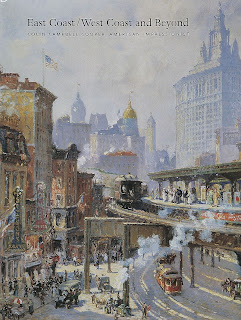Main Street Bridge Rochester
Source magart.rochester.edu
Memorial Art Gallery (Rochester, New York)
From wikimedia.org
Colin Campbell Cooper, Jr. (March 8, 1856 – November 6, 1937) was an American Impressionist painter, perhaps most renowned for his architectural paintings, especially of skyscrapers in New York City, Philadelphia, and Chicago. An avid traveler, he was also known for his paintings of European and Asian landmarks, as well as natural landscapes, portraits, florals, and interiors. In addition to being a painter, he was also a teacher and writer. His first wife, Emma Lampert Cooper, was also a highly regarded painter. His mother, Emily Williams Cooper, whose ancestor emigrated to the U.S. from Weymouth, England, was an amateur painter in watercolors. His father, Dr. Colin Campbell Cooper, whose grandfather came from Derry, Ireland, was a surgeon and a lawyer with a great appreciation for the arts. Young Colin had been inspired by the art which he discovered when he attended the Philadelphia Exposition of 1876. Both of his parents were highly supportive of his ambitions, encouraging him to become an artist.
(Wikipedia, the free encyclopedia)
Wall Street Ferry Ship
From fineartamerica.com
Broad Street Station Philadelphia
Lower broadway in wartime
Mountains of Manhattan
Images from canvaz.com
Cooper was as proficient painting in watercolors as he was in oils. He would often create a small watercolor study before painting a larger work of the same subject in oils. But the smaller watercolors were not mere sketches for his own use; they were finished pieces which he exhibited, sometimes years earlier than the larger corresponding oil paintings that he would ultimately produce. Cooper was elected to a prestigious membership in the National Academy of Design in 1912 (he had previously been elected an Associate, four years earlier).
(Wikipedia, the free encyclopedia)
East Coast, West Coast and Beyond
From images.monstermarketplace.com
Cooper’s acclaimed cityscapes of the East Coast celebrate the modern, fast-paced city and the progress represented by its quickly-changing skylines. Finally, Cooper’s west coast works depict his continued interest in monumental architecture throughout his career, including paintings of the “city” created for the Panama-Pacific Exposition of 1915 in San Francisco as well as more intimate scenes of figures and gardens bathed in sunlight. (heckscher.org) Summer Sailing From stanfordfineart.net Grand Central Station Poll and Canadian Building Taj Mahal Afternoon Images from oceansbridge.com It seems clear that a great deal of Cooper's skill in architectural painting is due at least in part to his understanding of the fundamental structure underlying the "skin" of a building, which Cooper could easily have extrapolated from his (then somewhat shocking) studies of anatomy with Thomas Eakins. Certainly Cooper is primarily known as an American Impressionist painter of the skyscraper. However, Cooper was not just an architectural painter. His portraits are lively and have a very personal quality which are an accurate reflection of the personalities he painted. His landscapes, even the quick gouache sketches with which he documented his travels, have a strong spirit of place.
In the later part of his life Cooper wrote about his choices of subject matter, "While architectural subjects have always delighted me, yet I have never wanted to confine myself to one class of subject, which has always seemed to limit the joy of it--life is so full of interesting things."
(sullivangoss.com)
After his wife's death, Cooper moved to Santa Barbara, California in January 1921. Santa Barbara would be his home base for the rest of his life, spending two years in northern Europe and Tunisia. He became Dean of Painting at the Santa Barbara Community School of Arts. In April 1927, he married his second wife, Marie Henriette Frehsee, in Arizona. Cooper continued to enjoy traveling, and kept painting until prevented from doing so by failing eyesight in his last years. He died in Santa Barbara on November 6, 1937 at the age of 81. In 1938 Santa Barbara's Faulkner Memorial Art Gallery paid tribute to Cooper's legacy by presenting a memorial exhibition of his work.
(Wikipedia, the free encyclopedia)





